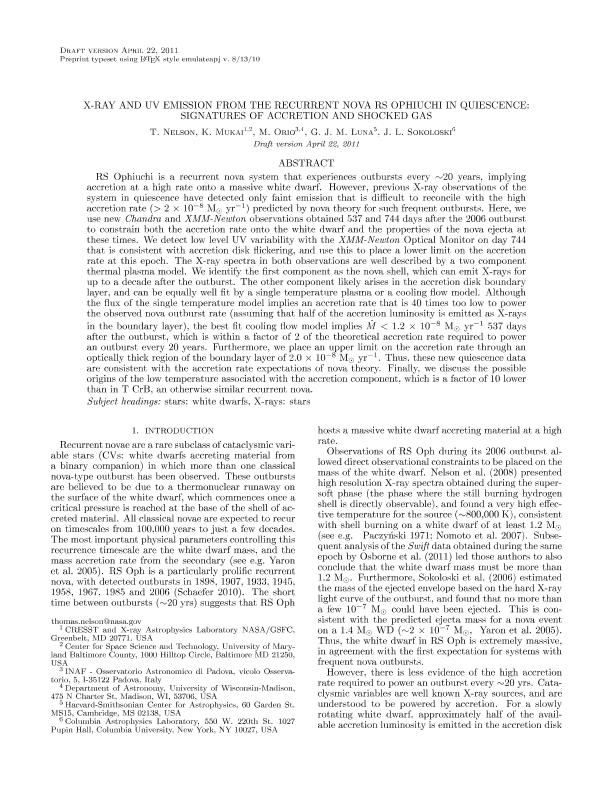Artículo
X-ray and ultraviolet emission from the recurrent nova rs ophiuchi in quiescence: signatures of accretion and shocked gas
Fecha de publicación:
07/2011
Editorial:
Iop Publishing
Revista:
Astrophysical Journal
ISSN:
0004-637X
Idioma:
Inglés
Tipo de recurso:
Artículo publicado
Clasificación temática:
Resumen
RS Ophiuchi is a recurrent nova system that experiences outbursts every ~20 years, implying accretion at a high rate onto a massive white dwarf. However, previous X-ray observations of the system in quiescence have detected only faint emission that is difficult to reconcile with the high accretion rate (>2 × 10–8 M yr–1) predicted by nova theory for such frequent outbursts. Here, we use new Chandra and XMM-Newton observations obtained 537 and 744 days after the 2006 outburst to constrain both the accretion rate onto the white dwarf and the properties of the nova ejecta at these times. We detect low level UV variability with the XMM-Newton Optical Monitor on day 744 that is consistent with accretion disk flickering, and use this to place a lower limit on the accretion rate at this epoch. The X-ray spectra in both observations are well described by a two component thermal plasma model. We identify the first component as the nova shell, which can emit X-rays for up to a decade after the outburst. The other component likely arises in the accretion disk boundary layer, and can be equally well fit by a single temperature plasma or a cooling flow model. Although the flux of the single temperature model implies an accretion rate that is 40 times too low to power the observed nova outburst rate (assuming that half of the accretion luminosity is emitted as X-rays in the boundary layer), the best-fit cooling flow model implies < 1.2 × 10–8 M yr–1 537 days after the outburst, which is within a factor of two of the theoretical accretion rate required to power an outburst every 20 years. Furthermore, we place an upper limit on the accretion rate through an optically thick region of the boundary layer of 2.0 × 10–8 M yr–1. Thus, these new quiescence data are consistent with the accretion rate expectations of nova theory. Finally, we discuss the possible origins of the low temperature associated with the accretion component, which is a factor of 10 lower than in T CrB, an otherwise similar recurrent nova.
Archivos asociados
Licencia
Identificadores
Colecciones
Articulos(ICATE)
Articulos de INST.D/CS ASTRONOMICAS D/LA TIERRA Y DEL ESPACIO
Articulos de INST.D/CS ASTRONOMICAS D/LA TIERRA Y DEL ESPACIO
Citación
Nelson, T.; Mukai, K.; Orio, M.; Luna, Gerardo Juan Manuel; Sokoloski, J. L.; X-ray and ultraviolet emission from the recurrent nova rs ophiuchi in quiescence: signatures of accretion and shocked gas; Iop Publishing; Astrophysical Journal; 737; 1; 7-2011; 7-23
Compartir
Altmétricas




